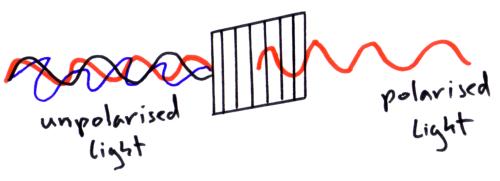Mechanical waves occur in a medium (solid, liquid or gas).
Longitudinal waves are waves where the displacement of the particles in the the same direction as the wave is travelling in. For example sound waves.

Transverse waves are waves where the displacement of the particles in the medium is perpendicular to the direction the wave is travelling in. For example water waves.

Electromagnetic waves are oscillating electric an magnetic fields they include radio waves, microwaves, infra-red, visible light, ultra-violet, x-rays and gamma rays. Electromagnetic waves are transverse waves and they all travel at the speed of light ( 3 x 108 ms-1 ) in a vacuum.
Transverse waves can be polarised but longitudinal waves cannot. Unpolarised light is a mixture if waves in different planes. When this light is passed through a polaroid material only light waves in one plane are transmited and the light is now polarised.

Polaroid sunglasses are popular with fishermen they reduce glare by blocking the reflected polarised light from the waters surface.



